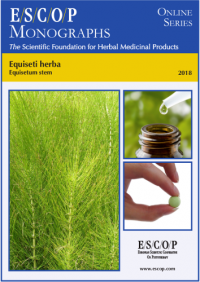Equiseti herba
Equisetum stem (Horsetail stem)
Equisetum arvense L.
Published 2018
Format: PDF

ESCOP monographs The Scientific Foundation for Herbal Medicinal Products. Online series. Equiseti herba (Equisetum Stem). Exeter: ESCOP; 2018.
Online viewing (for only ¤30 per year, you can view online all themonographs)
SUMMARY:
The herbal monograph selects and summarises scientific studies and
textbooks regarding efficacy, dosage and safety to support the
therapeutic uses of equisetum stem (synonym = horsetail stem).
This herbal drug by definition consists of whole or cut, dried sterile aerial parts of Equisetum arvense L.
Studies with its main characteristic constituents flavonoids, silica, caffeic acid esters, styryl pyrone glucosides, sterols, essential oil and thiaminase are included.
The therapeutic indications are irrigation of the urinary
tract, especially in cases of inflammation and renal gravel, as an
adjuvant in the treatment of bacterial infections of the urinary tract
and topically as a wound healing agent.
Administration of equisetum stem addressed posology; its
duration of use; contra-indications; special warnings; special
precautions for use; interactions with other medicinal products; other
forms of interaction; in pregnancy and lactation; its effects on ability
to drive; undesirable effects; overdose.
In vitro experiments with equisetum stem demonstrated antibacterial, antioxidant and anti-inflammatory effects.
In vivo experiments with animals using equisetum stem or its
extracts demonstrated anti-inflammatory, antidiabetic, as well as wound
healing properties.
Preclinical safety data for equisetum stem extract were assessed.
Pharmacological studies in humans concerned diuretic and wound healing activities.
Controlled clinical studies with equisetum stem extract demonstrated its diuretic and wound healing activity in patients.
Preclinical safety data were assessed in toxicity studies with rats.
The selection of literature cited in the monograph is aimed at
bringing together relevant information about the possible physiological
roles of equisetum stem and its major constituents.
KEYWORDS:
- Equiseti Herba (Horsetail stem)
- Equisetum arvense L.
- Urinary tract inflammation
- Urinary tract bacterial infection
- Renal gravel
- Wound healing agent



